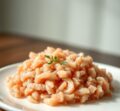So, you’ve cooked up a big batch of sausage, and now you’re wondering whether you can refreeze it for later. Well, good news! Refreezing cooked sausage is totally possible, but there are a few things you need to keep in mind to keep it safe and tasty. While freezing helps preserve the flavor and texture, the process can affect the sausage’s quality if not done right. In this guide, we’ll walk you through everything you need to know about safely refreezing cooked sausage, including tips on how to store it, how to thaw it, and the best practices to make sure your sausage still tastes great when you’re ready to eat it again.
Can You Refreeze Cooked Sausage?

Sausage is a beloved food across the globe, whether it’s sizzling on a grill, nestled in a bun, or served up with breakfast. But what happens when you have leftover cooked sausage, and you’re unsure whether you can freeze it for later use? It’s a common dilemma in many households, especially when you’re dealing with extra portions after a big meal. So, can you refreeze cooked sausage?
The short answer is yes, you can refreeze cooked sausage, but there are some important guidelines to follow to ensure food safety and preserve the quality of the sausage. Freezing cooked sausage is a way to extend its shelf life, but the key question is whether it’s safe and effective. There are factors like the initial freezing process, how the sausage was cooked, and how it was handled post-cooking that affect whether refreezing is a good idea.
When cooked sausage is frozen the first time, the cells of the meat expand and contract as moisture is trapped inside. This can alter the texture and flavor. Refreezing introduces another cycle of freezing and thawing, which can exacerbate these changes. So, while technically it’s safe to refreeze cooked sausage, it’s vital to follow proper steps to maintain both food safety and quality.
How To Refreeze Cooked Sausage?
Refreezing cooked sausage properly starts with understanding the thawing process. First and foremost, cooked sausage must be thawed in the right way. If it was initially frozen and thawed in the refrigerator, and it has not been left out at room temperature for more than two hours, you can refreeze it. The USDA strongly advises against refreezing food that was thawed at room temperature because this increases the risk of bacterial growth, which could lead to foodborne illness.
Here’s the process for refreezing cooked sausage in the safest and most effective way:
- Cool the Sausage Properly: Once you’ve cooked and eaten part of your sausage, make sure any leftover sausage is cooled quickly before you freeze it. The goal is to avoid allowing it to sit at room temperature for extended periods, as this can encourage bacterial growth. The USDA recommends refrigerating or freezing food within two hours of cooking.
- Storage: If you’re planning to freeze leftover sausage, place it in an airtight container or heavy-duty freezer bag. Vacuum-sealing is an excellent method for preserving the sausage’s flavor and preventing freezer burn. If using a freezer bag, try to remove as much air as possible. This will prevent moisture loss and keep the sausage tasting fresh.
- Label and Date: To keep track of the frozen sausage, label the storage container or bag with the date it was originally cooked. This will help you keep tabs on how long it’s been frozen. Generally, cooked sausage can be refrozen and consumed within one to two months for the best flavor and texture.
- Thawing the Refrozen Sausage: When you’re ready to use your refrozen sausage, avoid thawing it at room temperature. Instead, defrost it in the refrigerator overnight. This method helps preserve the sausage’s texture and flavor while keeping it safe. If you’re in a rush, you can also defrost it in the microwave or a cold-water bath, but these methods can sometimes lead to a soggier texture.
- Reheat Properly: Once thawed, reheat your sausage to a temperature of 165°F (74°C) before consuming. This ensures that any bacteria that may have formed during the thawing process are eliminated.
Quality Impact
When it comes to freezing and refreezing, the biggest concern is the impact on quality. Every time you freeze and thaw sausage, the moisture within it forms ice crystals. These ice crystals can puncture the sausage’s cell walls, causing it to lose some of its original texture. This process results in a loss of moisture during the reheating stage, leaving you with a potentially dry or rubbery texture.
The effect on flavor is less dramatic but still notable. Sausage can lose some of its juiciness and flavor intensity after multiple freeze-thaw cycles. Additionally, freezer burn can set in if the sausage is not stored properly. Freezer burn happens when air reaches the food, causing dehydration and a change in color, often leading to an unappetizing appearance and an altered taste.
However, if you handle cooked sausage correctly-by freezing it as soon as possible, using airtight packaging, and minimizing the number of freeze-thaw cycles-you can maintain a good level of quality. While the sausage may not taste as fresh as when it was first cooked, it can still be quite enjoyable, especially when incorporated into dishes like casseroles, soups, or pasta where texture isn’t as critical.
You can refreeze cooked sausage, but it comes with certain trade-offs in terms of food quality. The process is safe as long as the sausage has been handled and stored properly, following the recommended guidelines for cooling, packaging, and thawing. The quality of the sausage may degrade with each freeze-thaw cycle, particularly when it comes to texture and moisture content.
While refreezing isn’t ideal if you’re hoping for the same level of taste and texture as freshly cooked sausage, it is an effective way to extend its shelf life and reduce food waste. For the best results, aim to consume refrozen sausage within one to two months and be mindful of how you store and thaw it. Ultimately, by taking the proper precautions, you can safely refreeze cooked sausage without significantly compromising its safety or flavor.
Is It Safe To Refreeze Cooked Sausage?
When it comes to food safety, the question of whether it is safe to refreeze cooked sausage can seem tricky. The short answer is: yes, it can be safe-but with some important conditions and considerations. The key factor that determines whether refreezing is safe for cooked sausage is how it has been handled from the moment it was cooked to the point it’s being refrozen.
Temperature and Time Matters
If the sausage has been cooked thoroughly and then cooled down properly (i.e., within two hours of cooking), it can be refrozen. The danger zone for bacterial growth is between 40°F (4°C) and 140°F (60°C), and if cooked sausage has spent more than two hours in this range, it could be unsafe to refreeze, as harmful bacteria might have multiplied. This risk increases if the sausage is not properly cooled or is left at room temperature for too long before being frozen.
How Many Times?
Refreezing cooked sausage multiple times is generally not advised. Every time food is thawed and refrozen, it loses moisture, texture, and flavor. Most importantly, repeated thawing and refreezing increase the risk of bacterial growth, which is why the general rule of thumb is to only refreeze once.
Best Practices for Refreezing
To ensure safety and quality, it’s best to freeze cooked sausage as soon as it cools to room temperature (but not left at room temp too long). Use an airtight container or freezer-safe bag to prevent freezer burn, which can degrade both taste and texture. Label the container with the date of freezing so that you know how long the sausage has been stored.
Signs That Cooked Sausage Should Not Be Refrozen
While refreezing cooked sausage is safe under certain conditions, there are times when it’s best to avoid it altogether. Here are the telltale signs that cooked sausage should not be refrozen:
1. Off Smell or Sour Odor
If the sausage develops a sour or off-putting smell at any point before or after thawing, it is no longer safe to consume, let alone refreeze. Spoiled sausage can carry harmful bacteria like Salmonella or E. coli, which pose serious health risks. Trust your senses-if it smells bad, don’t risk it.
2. Slimy Texture or Color Change
Sausage that is slimy to the touch or shows significant discoloration (like green or gray spots) is a sign that bacterial growth has occurred. In this case, refreezing should be avoided as these textures and colors suggest the sausage is no longer safe for consumption.
3. Exceeding Storage Time
If the sausage has been sitting in the fridge for more than 3-4 days after cooking, it’s best not to refreeze. The longer food sits, the more its quality deteriorates, and the more likely it is to harbor harmful bacteria. Always check the expiration date on any pre-packaged sausage and avoid refreezing beyond the recommended storage period.
4. Inconsistent Freezing
If you notice that the sausage has been thawed and refrozen more than once, or if it’s been in the freezer for an extended period (like 6 months or more), it’s no longer safe to refreeze. Even if the sausage still looks and smells fine, there’s a chance that harmful bacteria have multiplied or the texture has become compromised.
Common Refreezing Mistakes
Refreezing cooked sausage may seem straightforward, but many people make critical mistakes that can affect food safety or quality. Here are some common errors to avoid:
1. Not Cooling the Sausage Properly Before Freezing
One of the most frequent mistakes is not allowing sausage to cool completely before freezing it. Freezing cooked sausage while it’s still warm can cause condensation to form inside the container, which leads to ice crystals and freezer burn. Moreover, freezing hot food can cause the internal temperature of your freezer to rise, which may put other food at risk of spoiling.
2. Refreezing after Extended Thawing
Refreezing sausage after it has been thawed for too long or improperly thawed (e.g., left out on the counter for hours) can lead to an increased risk of foodborne illness. The best way to thaw sausage is in the refrigerator, where it remains at a safe, consistent temperature. Never thaw sausage on the counter, as the outer layers can warm up quickly and promote bacterial growth.
3. Freezing Sausage in Large Portions
Another common mistake is freezing cooked sausage in large portions. When you freeze in bulk, it becomes much harder to thaw only the amount you need later, and you may end up thawing the entire batch, just to refreeze it. Instead, portion out your cooked sausage into smaller, manageable servings before freezing. This prevents waste and ensures food safety when reheating.
4. Not Using Airtight Packaging
Not properly sealing cooked sausage in airtight packaging is another frequent mistake. The air exposure can cause freezer burn, which affects the texture and flavor of the sausage. Additionally, it makes the sausage more vulnerable to contamination. To avoid this, always use high-quality freezer bags or containers, and expel as much air as possible before sealing.
Tips And Tricks
To help you properly refreeze cooked sausage while maintaining food safety and quality, here are some expert tips:
1. Cool Quickly
To avoid the risk of bacterial growth, cool your cooked sausage rapidly before freezing. You can place it in a shallow dish to allow it to cool more quickly, or place the sausage in an ice water bath for a few minutes. The faster you cool it, the better.
2. Use the Right Packaging
For best results, wrap the sausage tightly in plastic wrap or aluminum foil, then place it in a freezer-safe bag or container. This helps protect the sausage from freezer burn and prevents air from entering. Additionally, label the packaging with the date so you know exactly how long it’s been in the freezer.
3. Thaw Safely
When you’re ready to use the sausage, be sure to thaw it in the refrigerator rather than on the counter. This ensures that it remains at a safe temperature as it thaws. If you’re in a hurry, you can thaw it in the microwave or in cold water (change the water every 30 minutes), but refrigeration is always the safest method.
4. Avoid Multiple Freezing Cycles
Limit the number of times you freeze sausage. It’s best to only freeze cooked sausage once and consume it within a reasonable time (typically within 1-2 months). Each freezing and thawing cycle degrades the sausage’s texture, flavor, and overall quality.
5. Use It Within a Month or Two
While cooked sausage can stay frozen for up to 2-3 months for optimal quality, try to use it within the first month. The sooner you consume it, the better the taste and texture will be.
Conclusion
Refreezing cooked sausage can be done safely if you follow some important guidelines. The key is proper handling before freezing, as well as mindful storage practices. Always ensure the sausage is cooked, cooled, and frozen within safe time frames to minimize the risk of bacterial contamination. By following the proper steps and avoiding common mistakes, you can enjoy the convenience of refrozen sausage while still maintaining its quality and safety. So, while it is possible to refreeze cooked sausage, it’s essential to do so thoughtfully and with caution to ensure the best culinary outcome.


